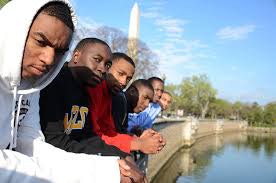
“We cannot control what has happened to Black students before they start higher education; we can only control their experience once on campus,” said Antwan Perry, the Germanna Community College academic advisor and counselor.
Perry hosted two interactive activities designed to have its participants identify perpetuated stereotypes about minority men, with the goal of encouraging productive interaction between faculty, staff and administration, and African-American male students. The multiethnic attendees of the session broke into groups, where they wrote as many stereotypes applicable to Black men as they could, which were then discussed with the larger group.
The other exercise consisted of a series of true or false statements, including that there are more Black men in prison than in college. The participants were divided as to the accuracy of the statement, however those who believed it to be true came to understand that the oft-repeated “fact” is a stereotypical myth. One person in the session stated that she “wanted to implement these exercises in her classroom.” Many in the room felt that the use of words like thug, angry and lazy to describe Black men are unfair assessments used on their campuses and discussions like these will change the mentality of staff.
Questions also arose on how to effectively engage African-American students.
“Part of successful engagement with African-Americans is to simply not stereotype them,” said Perry. “If Black students are going to a predominantly White institution, then they might not know how to respond to nuanced racism in the form of stereotypes.”
That, it was noted, could lead to issues of confusion about recourse on a campus where faculty and staff are not seeing eye-to-eye with minority students and where the students, in turn, feel like they are being judged unfairly based on stereotypes.
“If the majority of faculty and staff are White, then the students do not necessarily know who to turn to or where to go,” said Perry.
Other panel discussions on the African-American male college experience at the conference included success strategies for minority males and creating learning communities where Black men excel academically.
Increasing Black male enrollment persistence, retention and completion were underscored in a program at Baltimore City Community College (BCCC). Presenter Duane Reid, director at the Predominantly Black Institution Academic Acceleration for African American Males program, pointed out that “African-American males are taking an average of 10 years to complete an associate’s degree, which is four years longer than any other ethnic group. African-American females are completing associate’s degrees in eight years and six years for any other ethnic group.”
Reid, whose PBI 4A program of 85 students was launched in 2012 at BCCC, emphasizes the need for more Black males to graduate. “Access to higher education is always the discussion but not enough is focused on getting them out,” he said.
The U.S. Census reports that 23.4 percent of Baltimore City’s population is below the poverty line as of 2012, with a 63 percent African-American population. The PBI 4A program, among many benefits, offers mentorship, bus pass assistance, textbook discount programs, a guest speaker series and prescriptive tutoring, where students are provided individual assessments on specific subjects and are placed with appropriate experts.
Reid’s group of students is “impressed with the high percentage of increased GPA and graduation rates since the program has launched, but encourages his staff not to be, since there is much more work to be done.”.
Jamal E. Mazyck can be reached at [email protected] and on Twitter at @jmbeyond7.















